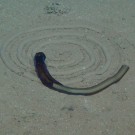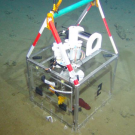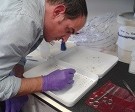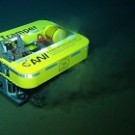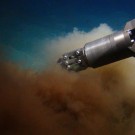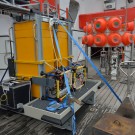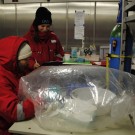***English version below*** von Ulrike Schroller-Lomnitz, Nikole Lorenz und Kristin Hamann Als wir die Initiative „Für ein gutes Miteinander auf See“ zur Prävention von sexualisierten Grenzverletzungen ins Leben gerufen haben, wurden wir immer wieder gefragt, ob wir so etwas wirklich brauchen. Oft hieß es: „Gibt es denn wirklich so viele Vorfälle?“Wie viele Vorfälle es tatsächlich […]
Science Day Espresso-Talk: “For a good way of working and living together at sea”
Am 05.09.2022 fand am GEOMAR erstmalig der Science Day statt. Schätzungsweise über 300 Teilnehmende nutzten die Möglichkeit ihre Arbeit in kurzen Präsentationen, Postern und Führungen allen Kolleg:innen am GEOMAR vorzustellen. Das Interesse an dem Austausch war groß und der Hörsaal bis auf den letzten Platz besetzt. Unter den vielen wissenschaftlichen Einblicken, widmete sich der Vortrag […]
Traces of life
Antje Boetius, Autun Purser, Yann Marcon During this 4-week expedition we have been very busy with studying traces of human activity at depth on scales of centimeters to kilometers. There was so much to be learned from this study site at 4150 m water depth. But it is important to remember that the ploughing […]
CUBEs – Why do we place ‘mini’-houses on the seafloor?
It may not always be easy to see, but the deep seafloor is teeming with life! Microbes and worms live inside the sediment and large sea cucumbers crawl over the sediment. This life will probably be heavily disturbed if the industry gets permission to collect manganese nodules and remove or plough through the top layer […]
Testing new technology: Underwater Hyperspectral Imager
Being able to test brand new technology is always exciting. The Ecotone Scientific UHI (Underwater Hyperspectral Imager) brought from NTNU in Norway was finished only a week before the Sonne disembarked from Guayaquil. It is the first UHI to be designed for deep sea use (6000m). Any untested equipment will present some initial challenges. During […]
“Why are you doing this research?” – Questions of the International School in Bremen
Questions from a school class A number of the scientists and crew taking part in SO242-2 are based in Bremen, Germany. We have received a number of interesting questions from year 6 students attending the International School Bremen, sent to us by their teacher, Martyn Robinson-Slater. We in this blog will try and answer some […]
What lives, breathes – New technology to measure respiration in the deep sea
Today we present the benthic crawler “Tramper” and it first steps at the seafloor in 4150m water depth. Tramper was designed and constructed within the HGF Allianz ROBEX (http://www.robex-allianz.de/) to measure oxygen concentration in the sediment autonomously over a longer period (up to one year). During this expedition we performed the first in situ test […]
Only dust in the wind? How we trace particles suspended by human activities at the deep-sea floor
In addition to a direct disturbance by an industrial collection of nodules at the seafloor, potential impacts of nodule mining are connected to the associated generation of sediment plumes and their dispersal. This may vastly extend the area that is affected by mining activities. Deep-sea sediments are typically very fine and easily eroded – it […]
Toolboxes at the seafloor
Our ROV (remotely operated vehicle) substitutes our eyes and arms at depth, but the amount of instrumentation it is able to carry (the so-called payload) is limited to the available space and weight of the payload in water since the ROV is kept buoyant by its own floatation (the yellow syntactic foam on the upper […]
Polar suits in the Pacific – sediment sampling for geochemical analyses
¡Hola! We are Seinab and Sophie from Jacobs University Bremen. It is the first big research cruise for both of us and we are excited to be part of it. Instead of looking at sea cucumbers and worms, we work with mud. Here we would like to give an introduction to the geochemical sampling we […]
